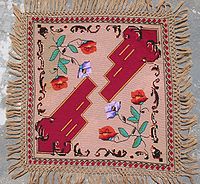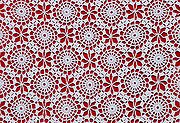
Tablecloth
Encyclopedia



Textile
A textile or cloth is a flexible woven material consisting of a network of natural or artificial fibres often referred to as thread or yarn. Yarn is produced by spinning raw fibres of wool, flax, cotton, or other material to produce long strands...
used to cover a table
Table (furniture)
A table is a form of furniture with a flat and satisfactory horizontal upper surface used to support objects of interest, for storage, show, and/or manipulation...
. Some are mainly ornamental coverings, which may also help protect the table from scratches and stains. Other tablecloths are designed to be spread on a dining table before laying out tableware
Tableware
Tableware is the dishes or dishware , dinnerware , or china used for setting a table, serving food, and for dining. Tableware can be meant to include flatware and glassware...
and food.
Ornamental tablecloths can be made of almost any material, including delicate fabrics like embroidered silk
Silk
Silk is a natural protein fiber, some forms of which can be woven into textiles. The best-known type of silk is obtained from the cocoons of the larvae of the mulberry silkworm Bombyx mori reared in captivity...
. Dining cloths are typically made of cotton
Cotton
Cotton is a soft, fluffy staple fiber that grows in a boll, or protective capsule, around the seeds of cotton plants of the genus Gossypium. The fiber is almost pure cellulose. The botanical purpose of cotton fiber is to aid in seed dispersal....
, a poly
Polyester
Polyester is a category of polymers which contain the ester functional group in their main chain. Although there are many polyesters, the term "polyester" as a specific material most commonly refers to polyethylene terephthalate...
-cotton blend, or a PVC
PVC
Polyvinyl chloride is a plastic.PVC may also refer to:*Param Vir Chakra, India's highest military honor*Peripheral venous catheter, a small, flexible tube placed into a peripheral vein in order to administer medication or fluids...
-coated material that can be wiped clean, but they can range from functional coverings to fine textiles, as long as they can be laundered. Some cloths are designed as part of an overall table setting, with coordinating napkins, placemat
Placemat
A placemat is a protective table pad usually made of paper, plastic or cloth for restaurants and households. Asian-style placemats may feature thin slats of bamboo or colourful beads. The term is derived from the mat being put at a person's "place" at a table.- Uses :Their primary function is to...
s, or other decorative pieces. Special kinds of tablecloth include runners which overhang the table at two ends only, and table protectors to provide a padded layer under a normal cloth.
History
In many European cultures a white, or mainly white, tablecloth used to be the standard covering for a dinner table. In the later medieval period spreading a high quality white linenLinen
Linen is a textile made from the fibers of the flax plant, Linum usitatissimum. Linen is labor-intensive to manufacture, but when it is made into garments, it is valued for its exceptional coolness and freshness in hot weather....
or cotton cloth was an important part of preparing for a feast in a wealthy household. Over time the custom of arranging tableware on a cloth became common for most social classes except the very poorest. As eating habits changed in the 20th century, a much greater range of table-setting styles developed. Some formal dinners still use white tablecloths, often with a damask weave, but other colours and patterns are possible.
Special cases
PerugiaPerugia
Perugia is the capital city of the region of Umbria in central Italy, near the River Tiber, and the capital of the province of Perugia. The city is located about north of Rome. It covers a high hilltop and part of the valleys around the area....
tablecloths and napkins have been made since medieval times. White with characteristic woven blue stripes and patterns, the style is also associated with church linen
Altar cloth
An ' is used by various religious groups to cover an altar. Christianity, ancient Judaism, and Buddhism are among the world religions that use altar cloths....
.
Victorian
Victorian decorative arts
Victorian decorative arts refers to the style of decorative arts during the Victorian era. The Victorian era is known for its eclectic revival and interpretation of historic styles and the introduction of cross-cultural influences from the middle east and Asia in furniture, fittings, and Interior...
interiors were full of thick, fringed draperies in deep colours, including tablecloths reaching to the floor on any kind of table.
A popular "magic trick" involved pulling a loaded tablecloth away from a table but leaving the plates behind. This trick relies on inertia
Inertia
Inertia is the resistance of any physical object to a change in its state of motion or rest, or the tendency of an object to resist any change in its motion. It is proportional to an object's mass. The principle of inertia is one of the fundamental principles of classical physics which are used to...
.

